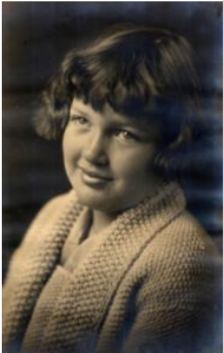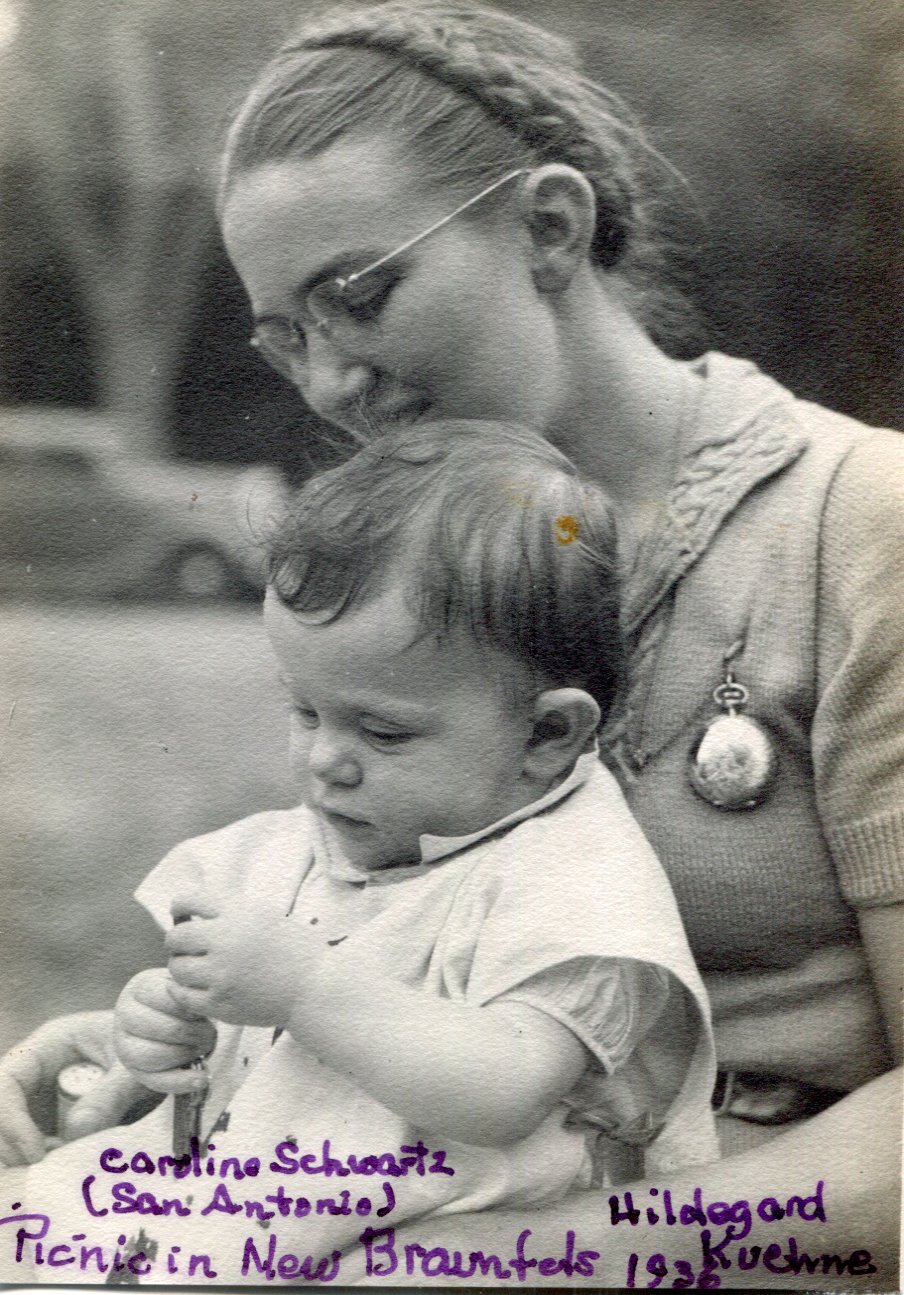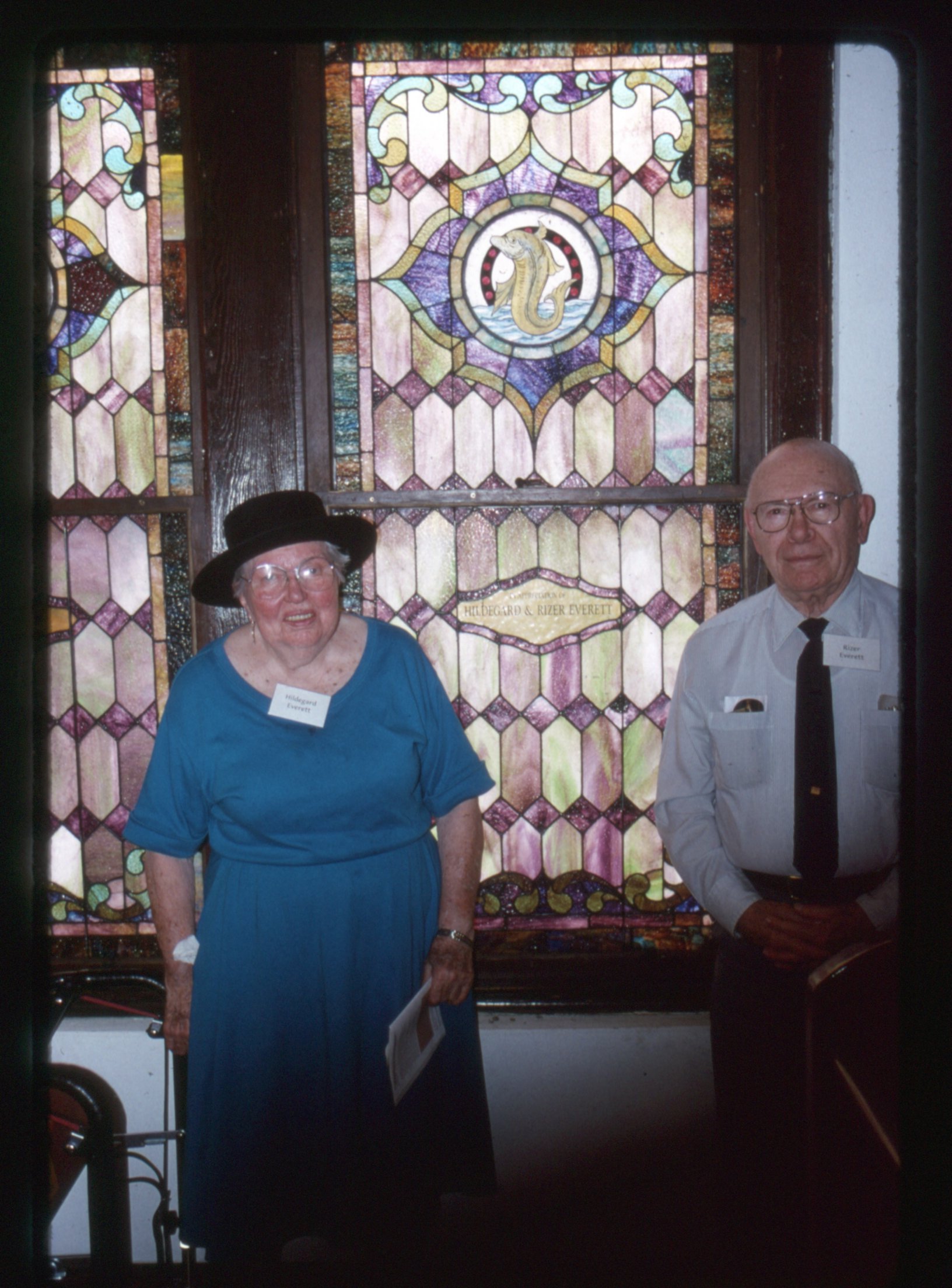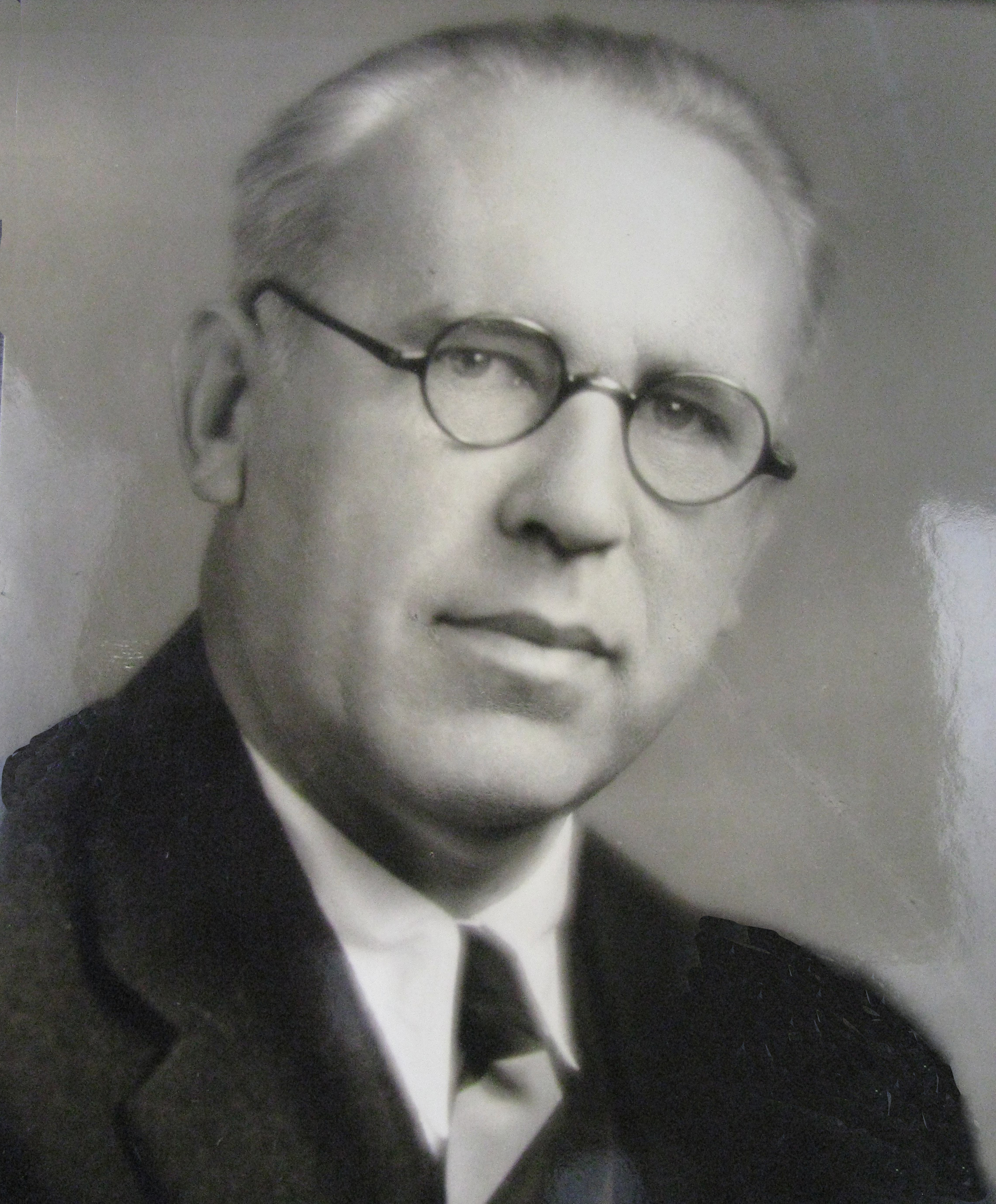Rizer and Hildegard Kuehne Everett

Rizer and Hildegard Kuehne Everett 1987
Rizer and Hildegard Kuehne Everett, were longtime members of the church. They were devoted to its ideals and principles. Both contributed in so many ways, Rizer's woodworking skills and Hildegard's decorating and culinary skills are part of their legacy.
Dot Everett Waldrip (who lives in Albuquerque) is Hildegard (1915–2001) and Rizer (1916–2003) Everett's daughter. I wrote to her and asked her for some memories about her folks who were pillars of the church for many years. Here, with a bit of editing, is what Dot had to say.
 Hildegard Kuehne was born February 21, 1915, in Austin in the house that her parents owned that was actually quite close to the church. The house has been made an historical landmark, though it was physically moved from where her mother was born to another lot in the neighborhood. At right we see Hildegard in about 1925
Hildegard Kuehne was born February 21, 1915, in Austin in the house that her parents owned that was actually quite close to the church. The house has been made an historical landmark, though it was physically moved from where her mother was born to another lot in the neighborhood. At right we see Hildegard in about 1925
 Rizer was born in Belmar, New Jersey, on June 9, 1916. His paternal grandmother wouldn't allow his mother to deliver in that far off land of Texas, so his mother took a train up to New Jersey. Rizer was the last son born in New Jersey; the other three were born in Austin. Photo at left is of Rizer at age two in 1918, with his Buster Brown haircut.
Rizer was born in Belmar, New Jersey, on June 9, 1916. His paternal grandmother wouldn't allow his mother to deliver in that far off land of Texas, so his mother took a train up to New Jersey. Rizer was the last son born in New Jersey; the other three were born in Austin. Photo at left is of Rizer at age two in 1918, with his Buster Brown haircut.
Hildegard and Rizer actually met in kindergarten. Dot says, "Mother only spoke German when she began attending kindergarten. One day she was speaking in English telling her parents about 'IT.' 'It sat by me today. It played ball. It did this and It did that.' Her parents were convinced she was using the wrong English pronoun, so they asked if It was a boy or a girl. Mother answered that 'It has hair like a girl but it dresses like a boy.' Dad's father had insisted that his boys have the old fashioned Buster Brown haircut. So that's why Rizer was IT since kindergar- ten for Hildegard."
They both attended Wooldridge School, but after kindergarten, they ran in different circles. Rizer skipped a grade at some point, so he was a grade ahead of Hildegard. Then they attended Austin High. They did meet again (in a story often told by the couple) in a photography class at UT taught by Hildegard's father, Dr. John Kuehne (who was one of the early members of this church) who was in the physics department. The romance developed, so to speak, from there. Rizer was a member of Phi Beta Kappe. Following graduation from UT, Rizer went to work for Carter Oil Company in Wichita, KS, which was the producing company for Humble.
They were married June 26, 1938, and since Rizer was a geologist, they lived in Illinois, Indiana, Kansas, South Dakota, Wyoming, Louisiana, Mississippi, Oklahoma, and several of those places two or three times before Dot was born in 1943. Their move to Indonesia in 1954 was their 28th move. The com- pany in Indonesia was essentially Exxon. Rizer was, as he liked to say, an Exxon annuitant. Dot believes they returned to the States in 1966. Hildegard and Rizer traveled extensively in Asia, Europe, Africa, South and Central America, in the United States, Mexico, and Canada, and loved every min- ute of it. Dot and her brother John attended boarding schools in India for much of their education.
After returning to Austin, Rizer got his pilot license and Hildegard her co-pilot license, however according to duaghter Dot, "Because right after they qualified Dad finally realized that flying with him scared mother to death. LOL. Dad loved it. Mother didn’t like the lack of certainty."
Dot says, "They loved coming back to Austin into the church. It meant a great deal to Mom and to Dad. When I was a child, my grandparents (the Kuehnes) were so close to all those people in the congregation, I thought we were related to many of them, especially Marie Clark. I think I was 16 by the time I figured out that we weren't really related to her, though what a wonderful person she was; what a wonderful friend to all of us."
"That church, that physical space, figures in so many of my memories from the time I was born. In recent years when I've gone back, I realize that the windows in the sanctuary form the core of my belief in God and understanding of Jesus and Christianity. Not a bad way to teach a child. When I think of coming back to Austin, it is returning to that sanctuary that I picture--the trio playing, Eleanor (Towery) and Mother in the fellowship kitchen making coffee, John Towery giving one of his too deep sermons, my grandfather and grandmother sitting in the second pew on the west side, and little Chesly Towery squirming in his seat." Thanks for the memories, Dot!!


Hidegard Kuehne with John Frost, son of Rev. S. E. Frost. At right is Hildegard with Connie Schwartz.
I still remember greeting this lovely "new" older couple who had come to church one Sunday—little realizing their long history with the church! —Pat

Rizer Everett, Austin High School, 1931

Hildegard Kuehnee, Austin High School, 1932.

Rizer Everett, University of Texas Senior, 1937

The church dedicated a stained glass window to the Everetts.


Hildegard Kuehne Everett Obituary, Austin American-Statesman, November 15, 2001,
Rizer's father was Freehand Drawing and Painting Professor Raymond Everett. Here is a biography of him:
Biographical Sketch of Raymond Everett
 Raymond Everett was born in Englishtown, N.J. on August 10, 1885 of Sarah Ella (neé Polhemus) Everett and Charles Randle Everett, a Presbyterian minister. His early education was in the public schools of New Jersey. He obtained a bachelor of arts degree in 1906 from Drexel Institute in Philadelphia, where he studied under Howard Pyle, a well-known book and magazine illustrator.
Raymond Everett was born in Englishtown, N.J. on August 10, 1885 of Sarah Ella (neé Polhemus) Everett and Charles Randle Everett, a Presbyterian minister. His early education was in the public schools of New Jersey. He obtained a bachelor of arts degree in 1906 from Drexel Institute in Philadelphia, where he studied under Howard Pyle, a well-known book and magazine illustrator.
After obtaining his degree from Drexel Institute, he attended Harvard University for three years and graduated in 1909 with a bachelor of science in architecture. From there he went to Pennsylvania State College where he taught freehand drawing and painting in the Department of Architecture from 1909 to 1910.
During the summer of 1910 he traveled in Europe, spending most of his time in the Mediterranean area. Everett made many notes and sketches, some of which he transferred to canvas and board.
From 1910 to 1915 Everett was an instructor of Architecture at the University of Michigan. He wrote in the Harvard Alumni Magazine (1933), "I was one-third of the teaching staff." While teaching at the University of Michigan he met and married Isabelle Rizer.
In 1915 the Everetts moved to Austin. Everett taught freehand drawing, painting, clay modeling and architectural history in the Department of Architecture at the University of Texas from 1915 until his death in 1948.

In 1931 Everett obtained his masters degree in architecture from the University of Texas. For this he painted a frieze in oil entitled "The March of Progress in Texas." The frieze depicted the History of Texas by showing the various types of people who lived in Texas at different times. Everett did much research in obtaining data for showing the kinds of costumes and types of horses used by the people of Texas. The frieze was made to fill the upper part of four walls of one room in his home. After his death it was moved to the University Junior High School in Austin. In 1968 the frieze was transferred to the Webb Junior High School in Austin where it hangs in the school library.
Raymond Everett was a creative artist who worked in several media. In his early years as a student at Drexel Institute and at Harvard, he developed his skill in pen and ink drawings. He used this skill during his entire career in designing greeting cards (copyright by Alfred Bartlett, Boston), book plates and commercial illustrations for magazines and posters. Some of the book plates he designed include: Art Institute of Chicago (1913); Free Public Library of Belmar New Jersey (1917); Burton Historical Collection of the Detroit Public Library (1915); Martha Cook Building at the University of Michigan (1915); Lucius L. Hubbard Collection of Treasure Island (1916); Lucius L. Hubbard National Collection of Gulliver (1916); Austin Public Library (1926); former governor of Texas Pat M. Neff (1947). In 1919 he designed the title block for the Austin Statesman. In the years 1918 to 1920, Everett designed the covers for the "Texas Legionnaire" and "The Austin Rotary Revue."
Everett painted landscapes and seascapes in watercolor, oil, and pastels. He experimented in various media for sculpture work including cement, plaster, and wood. He never worked with metal, but did design a number of works which were finished in wrought iron by other craftsmen.
At his home at 903 West 31st Street in Austin he made many changes using his many skills. He built rock walls, excavated rooms in the basement, remodeled rooms, added rooms, carved the fireplace mantles, patio gate and newel posts, and hung paintings on nearly all the walls of his home.
One of the crafts he enjoyed most was wood carving. During his career he carved several sets of chessmen, a number of plaques (two of which hang in the rotunda of the Union Building of the University of Texas - Harry Y. Benedict and Homer P. Rainey), many small boxes, a number of small chests, and several large chests, screens and many other items of furniture. The last wood carving he did before his death was the altar in St. Mary's Cathedral Church in Austin. During his lifetime he designed and carved several lecterns and pulpits for various churches in Austin.
During the 33 years he lived in Austin, Everett made many weekend excursions into the hills west of Austin and to the Gulf Coast seeking new scenes to record on his canvas and board. During the summer vacations he made longer trips into Mexico where he found the colorful markets, rugged terrain, and distinctive architecture interesting subjects for his paintings. Often he took students with him on these excursions and trips.
Everett was a man endowed with abundant physical endurance that served him well on his painting trips. He would sit for hours in the broiling sun at his easel sketching and painting. At his studio in the basement of his home he would later complete the details. He enjoyed living in Texas where the short winters permitted him to spend much of his spare time outdoors working on some form of creative art. When inclement weather or darkness kept him indoors, he worked on his paintings or wood carvings in his studio.
-Ardys Kozbial